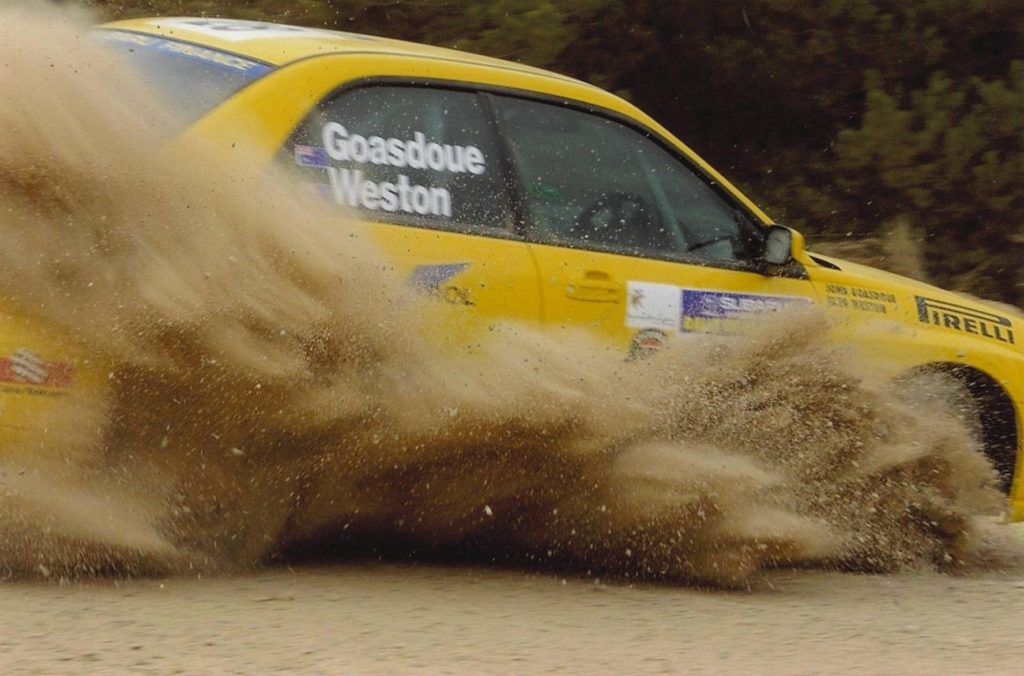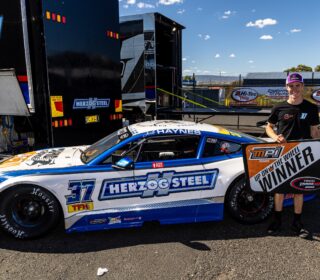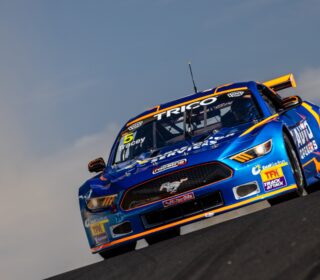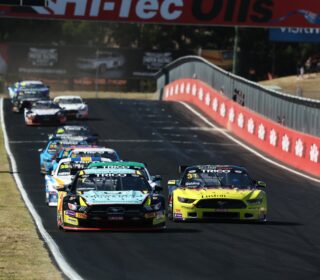WALKER: Drinking on the job

WORDS & PHOTOS: Mark Walker
Back when I was much younger than I am today, I participated in a large quantity of motorsport commentary.
Please note, the emphasis was on quantity, not necessarily quality.
Following on from my first after school job, where at the local shopping mall I spruiked cheap laundry detergent for the pharmacy, I was drafted by the nearby race track to commentate cars racing.
It probably wasn’t the career path Uncle Murray Walker took, but taking the sideways step from soap sales seemed like a natural progression.
Although I still enjoy having a very occasional ramble on a microphone, I never pursued it as a career.
Perhaps I didn’t have enough ego (probably), or maybe I lacked the necessary ability (more probably).
In long distance hindsight, perhaps it was youngster looseness that was my professional undoing.
Paid gigs in motorsport and drinking cold beer are generally incompatible activities. Somehow on three occasions (that I recall), I managed to mix a tipple with work. End results varied.
So, pour yourself a vessel of your favourite moonshine, and attempt to enjoy the following (probably) true tales.
V8 Supercars
For some reason that entirely escapes me, I had an altogether too brief of an apprenticeship calling Holden Gemini races at club meets before getting the call up to be the pit reporter at the QR V8 Supercars event.
Back in the black and white days of 2001, the local circuit commentary team would be complimented at V8 events by the legendary Barry Oliver, and for a time, he managed to bring his Tasmanian partner in crime David Rose along for the ride to the Queensland 500.
Quite how a snot nosed teen could share broadcast airwaves with commentary box royalty is mystifying. Less than 18 months earlier, a spoken assignment in front of half an English class full of school students would leave me a quivering mess, but interviewing Craig Lowndes on the grid at QR in front of 30,000 people seemed ok.
With workplace health a safety a newfangled buzz-phrase, it was thought to be a prudent move to supply the pit reporters with fire proof race suits. Natural selection had previously thinned out the pit report ranks of its clumsier, more flammable members.
That particular race ended with the Radisich/Johnson Falcon bunkered at turn one after an almighty thunderstorm swept across the venue.

Naivety was strong with this one, and my thinking was that if a race suit is fire proof, it would clearly be waterproof. Surely a can of Scotchgard would have been expended in production of the garment?
I was wrong. Entirely wrong.
After taking on the full force of the horizontal rain, I quickly discovered that not only do race suits not repel water, they actively retain it.
Following the podium presentation, where TV’s Mark Oastler used my microphone (what an honour), wrinkled, I returned to the relative dryness of the commentary box at the top of the tower.
The organisers of the meeting had scheduled an Improved Production race to follow on from the main event, a somewhat vain attempt to get the traffic to disperse over a longer period. Of course 98% of the audience by that stage were bogged axle deep in the car park cluster, and not watching Improved Production cars.
Also by this stage, the upstairs corporate area of the QR tower was teetering on the edge of drunken anarchy, with some big wigs in the sport taking to the bottle, hard. The then wife of one prominent identity decided to press her bare chest against the commentary box window, in a story for another day…
Due to a general lack of interest by the other commentators on duty, I was roped in to call the Improved Production race, which I did, accompanied by a Crown Lager I had liberated from the nearby festivities.
At race start, I was still decked out in my saturated fire proof regalia, and quite hypothermic. Shivering, I distinctly recall commentating into my stubby, and trying to drink from my radio mic.
Not entirely my best performance.
Rallying
I love rallying.
There is something about the mix of fresh air, the camaraderie of the competitors, and their utterly insane efforts to dodge various animal, vegetable and mineral objects though far flung forests that make it great.
For a stint, I truly enjoyed being on the Rally Queensland commentary team.
Led by Pat Hetherman, we ran quite a unique system that he developed utilising UHF radios broadcasting from a mid-stage regroup, back to the main spectator areas several kilometres away.
I distinctly recall one day Simon Evans rolling to a halt with the remnants of a tree piercing through the intercooler of his Corolla. No leaks, no worries.

Another indelible memory is members of the Subaru RS Challenge including Will Orders and the late great John Goasdoue having an impromptu panel beating competition somewhere out in the sticks.
One particular year, the Rally held a Super Special stage on the Saturday night through the streets of Kings Beach at Caloundra.
It was brilliant. Picture a typical Queensland seaside town, an international food festival, and a plastic barrier lined block of town broken up a couple of temporary chicanes.
The crowd was massive. 2,000 people? 10,000? It quite easily could have been 50,000, but whatever the number, it was impressive.
The job of trying to explain what was happening was left to myself, Pat, and my old partner in crime Mark Jones.
Pat took up his designated spot at the start/finish staging area, interviewing crews prior to departure, while Jonsey was sent to the far corner of the track.
I was nominated to stand on top of the tallest building in the middle of the block, and fill in the gaps. Yes sir, no problem!
Since that date, I’ve never been sure if Pat, or the rally organisers knew what was happening on top of that tower.
It seemed the rooftop area had been commandeered by the mayor of the city council (seriously, it might have been, but it possibly wasn’t), who used the space to throw quite the soiree.
For a young fella whose head holes were filled with the dust kicked up by a hundred rally cars, the seafood spread on offer was manna from heaven.
Moreton Bay bugs? Don’t mind if I do. A few Milton Mangoes? Sure, why not!
Commentary duties kicked off cordially enough. The fastest guys like Cody Crocker led the field away, and with their pinpoint precision seeing them navigate the course straight and true.
As the field wore down, the relative skills levels diminished, the value of the cars lowered, but the stars in the eyes of the drivers grew larger.
As more and more competitors put on a show for the crowd, smacking barriers and generally Ken Blocking it up, the commentator high above was progressively fed more and more beer.
The grand finale of the evening was the legendary Viv Gees and his hardtop Falcon. What a hero. The man did not disappoint, as he did his bit to assist with the barrier disassembly process.
The crowd by this stage was somewhat in a frenzy, egged on by the now significantly buzzed announcer.
The footnote to this was that Jonsey was handed the car keys to drive back to the accommodation, I was in no state to be in control of anything less than a large crowd of people.
Great success.
Hillclimb
The Noosa Hillclimb is two parts awesome, one part scary.
An old section of the highway that linked Noosa to the hinterland that had long since been bypassed, was once a year turned into a race track.
At times Rally Queensland had commandeered Gyndier Drive as a super special stage, and in more modern times, ‘The Hill’ now hosts a pair of more typical hillclimb events each season.
The track is quite the challenge, it goes right, left, right, left, repeating itself many, many times, until a final right-left takes you over the finish line.
Thick national park lines both sides of the road, with the left side accessible by punters, and the cliff on the right side inhabited by multiple species of large reptilians, who in some cases were simply non-paying spectators.
In the early days of competition, the lack of substantial barriers on the right hand led to more than one competitor taking a frightening shortcut back to the bottom of the hill. That said, competitors still found the trees on the left-hand side quite easily, and with significant force.
Over the years, the price of concrete decreased, or perhaps the value of cars increased, so more fences were erected along the run.
Held in November, the historic hillclimb had an end of year feeling to it. This may have been coupled with the fact that it was schoolies week, and Main Street was filled with youngsters not old enough to bluff their way into the pub.
My memory is somewhat hazy to the exact makeup of the commentary team on duty the weekend in question, but I do remember one fact: I was the youngest and skinniest talking head rostered on.
There is a single job applicable for the young/skinny one, and that’s to scale the mountain, and be the designated commentator stationed at the main spectator point at the top.
After the first few runs, we figured out the system: by the time the bottom of the hill commentators had interviewed the driver, called their take off, and run out of oxygen, the car in question was within eye sight of the top of the hill.
Complicating matters somewhat was a large LED sign displaying car speeds, that the organisers had erected at the end of a relatively straightish section of bitumen, opposite the spectator area.
The complicating factor was that the sign wasn’t pointed at the spectators, but rather the competitors as they drove up the course.
Many drivers however proved to be unaware that their cars were already fitted with a speedometer, with ultimate glory being a triple figure speed on the scoreboard.
Physics however dictated that anyone who bettered the 100km/h mark were also a 100% chance of going head first into the waiting concrete fence.
As far as spectator areas go, it was pretty basic, just some bunting to protect the fans from errant cars, and a makeshift bar.
Whether the bar was an official function of the race meeting, or simply an opportunistic liquor merchant, it kept fans boozed up while car after car was loaded onto the sole tilt tray after their brush with the speed barrier, followed shortly thereafter by the cement barrier.
After a while (it may have been minutes), the locals grew tired of the boring old talk about Ford Cortinas, and they started feeding the commentator some of the local product.
I’m a bit hazy on how this particular tale ends, but for the following year I was sequestered to the bottom of the hill, and nowhere near any XXXX.
Good times, classic hits.
While The Race Torque happily endorses Drink Commentating, we do not endorse Drink Driving. Stay safe on the roads, kids.. but have at it on the mic! – Ed.







